Webmasters! 3 Ways to 3D Web
02 March 2017 15:34
Ok, thank you. I had changed it and now it looks like this.
But it still not work properly.
b4w.register("app", function(exports, require) {
window.addEventListener("load", function() {
b4w.require("app","NS_1").init_1({
canvas_container_id: "container_id1",
callback: load_cb
});
b4w.require("app","NS_2").init_2({
canvas_container_id: "container_id2",
callback: load_cb
});
}, false);
}
function load_cb() {
b4w.require("data").load("redCube.json", loaded_cb);
}
function loaded_cb() {
b4w.require("app").enable_camera_controls();
}
<div id="canvas_cont_1"></div>
<div id="canvas_cont_2"></div>
But it still not work properly.
02 March 2017 15:53
This is the simple project - project.zip.
You can import it in the Project Manager.
Or.. do you need the another behavior?
You can import it in the Project Manager.
Or.. do you need the another behavior?
02 March 2017 16:26
02 March 2017 17:07
Hello
Do you mean this?
![]()
There are 4 interactive canvases on this page. I've attached the sources, just import it to you ProjectManager
Do you mean this?

There are 4 interactive canvases on this page. I've attached the sources, just import it to you ProjectManager
02 March 2017 17:22
02 March 2017 20:31
Well, I had tried to write it on my own, to understand blend4web. This is my code, but it unfortunately does not work.
b4w.register("sev_canvas_app", function(exports, require) {
// import modules used by the app
var m_app = require("app");
var m_data = require("data");
var m_preloader = require("preloader");
exports.init_1 = function() {
m_app.init({
canvas_container_id: "main_canvas_container_1",
callback: init_cb1,
show_fps: DEBUG,
console_verbose: DEBUG,
autoresize: true
});
}
exports.init_2 = function() {
m_app.init({
canvas_container_id: "main_canvas_container_2",
callback: init_cb2,
show_fps: DEBUG,
console_verbose: DEBUG,
autoresize: true
});
}
function init_cb1(canvas_elem, success) {
if (!success) {
console.log("b4w init failure");
return;
}
m_preloader.create_preloader();
// ignore right-click on the canvas element
canvas_elem.oncontextmenu = function(e) {
e.preventDefault();
e.stopPropagation();
return false;
};
load1();
}
function init_cb2(canvas_elem, success) {
if (!success) {
console.log("b4w init failure");
return;
}
m_preloader.create_preloader();
// ignore right-click on the canvas element
canvas_elem.oncontextmenu = function(e) {
e.preventDefault();
e.stopPropagation();
return false;
};
load2();
}
function load1() {
m_data.load(APP_ASSETS_PATH + "sev_canvas1.json", load_cb, preloader_cb);
}
function load2() {
m_data.load(APP_ASSETS_PATH + "sev_canvas2.json", load_cb, preloader_cb);
}
function preloader_cb(percentage) {
m_preloader.update_preloader(percentage);
}
function load_cb(data_id, success) {
if (!success) {
console.log("b4w load failure");
return;
}
m_app.enable_camera_controls();
}
});
// import the app module and start the app by calling the init method
b4w.require("sev_canvas_app").init_1();
b4w.require("sev_canvas_app").init_2();
<div class="wrapper">
<div id="main_canvas_container_1"></div>
</div>
<div class="wrapper">
<div id="main_canvas_container_2"></div>
</div>
03 March 2017 12:19
Hello,
You don't have to write init_cb1, init_cb_2. Look. In the example above, we have named our module "sev_canvas_app". It has standard functions: init, init_cb, load, load_cb. But we use this module several times:
We duplicated the init function twice, because we used different HTML elements: main_canvas_container_1 and main_canvas_container_2. We could write the following code and it would be the same:
The main code lines are placed in the end of this example:
Take a look at the "canvas_1" and "canvas_2" variables. They are called name space variables. They allow us to use one module twice. And each time, this module will be used as a new module.
Use the last code snippet
Anyway, we are going to write an article about this. I hope, it will be useful for users.
You don't have to write init_cb1, init_cb_2. Look. In the example above, we have named our module "sev_canvas_app". It has standard functions: init, init_cb, load, load_cb. But we use this module several times:
b4w.require("sev_canvas_app", "NS_1").init_1();
b4w.require("sev_canvas_app", "NS_2").init_2();
We duplicated the init function twice, because we used different HTML elements: main_canvas_container_1 and main_canvas_container_2. We could write the following code and it would be the same:
b4w.register("sev_canvas_app", function(exports, require) {
var _name_space = b4w.get_namespace(require);
// import modules used by the app
var m_app = require("app", _name_space);
var m_data = require("data", _name_space);
var m_preloader = require("preloader", _name_space);
var _loading_scene = "";
exports.init = function(canvas_container_id, loading_scene) {
_loading_scene = loading_scene;
m_app.init({
canvas_container_id: canvas_container_id,
callback: init_cb1,
show_fps: DEBUG,
console_verbose: DEBUG,
autoresize: true
});
}
function init_cb(canvas_elem, success) {
if (!success) {
console.log("b4w init failure");
return;
}
m_preloader.create_preloader();
// ignore right-click on the canvas element
canvas_elem.oncontextmenu = function(e) {
e.preventDefault();
e.stopPropagation();
return false;
};
load();
}
function load() {
m_data.load(APP_ASSETS_PATH + _loading_scene, load_cb, preloader_cb);
}
function preloader_cb(percentage) {
m_preloader.update_preloader(percentage);
}
function load_cb(data_id, success) {
if (!success) {
console.log("b4w load failure");
return;
}
m_app.enable_camera_controls();
}
});
// import the app module and start the app by calling the init method
b4w.require("sev_canvas_app", "canvas_1").init("main_canvas_container_1", "sev_canvas1.json");
b4w.require("sev_canvas_app", "canvas_2").init("main_canvas_container_2", "sev_canvas2.json");
The main code lines are placed in the end of this example:
b4w.require("sev_canvas_app", "canvas_1").init("main_canvas_container_1", "sev_canvas1.json");
b4w.require("sev_canvas_app", "canvas_2").init("main_canvas_container_2", "sev_canvas2.json");
Take a look at the "canvas_1" and "canvas_2" variables. They are called name space variables. They allow us to use one module twice. And each time, this module will be used as a new module.
Use the last code snippet
Anyway, we are going to write an article about this. I hope, it will be useful for users.

